 |  Using Information Technology Intro: A Practical Introduction to Computers and Communications, 5/e Stacey Sawyer
Brian K. Williams
Table of ContentsCHAPTER 1 INTRODUCTION TO INFORMATION TECHNOLOGY: Mind Tools for Your Future
1.1 Infotech Becomes Commonplace: Cellphones, E-Mail, the Internet, & the E-World
1.2 The “All-Purpose Machine”: The Varieties of Computers
1.3 Understanding the Computer: Pretending to Build Your Own PC
1.4 Where Is Information Technology Headed?
1.5 Infotech Becomes Commonplace: Cellphones, E-Mail, the Internet, & the E-World
1.6 The “All-Purpose Machine”: The Varieties of Computers
1.7 Understanding Your Computer: What If You Custom-Ordered Your Own PC?
1.8 Where Is Information Technology Headed?
CHAPTER 2 THE INTERNET & THE WORLD WIDE WEB: Exploring Cyberspace
2.1 Choosing Your Internet Access Device & Physical Connection: The Quest for Broadband
2.2 Choosing Your Internet Service Provider (ISP)
2.3 Sending & Receiving E-Mail
2.4 The World Wide Web
2.5 The Online Gold Mine: More Internet Resources, Your Personal Cyberspace, E-Commerce, & the E-conomy
CHAPTER 3 APPLICATION SOFTWARE: Tools for Thinking & Working More Productively
3.1 Application Software: Getting Started
3.2 Common Features of Software
3.3 Word Processing
3.4 Spreadsheets
3.5 Database Software
3.6 Specialty Software
CHAPTER 4 SYSTEM SOFTWARE: Power Behind the Power
4.1 The Components of System Software
4.2 The Operating System: What It Does
4.3 Other System Software: Device Drivers & Utility Programs
4.4 Common Operating Systems
4.5 The OS of the Future: “The Network Is the Computer”
4.6 Online Software &Application Service Providers: Turning Point for the Software Industry
CHAPTER 5 HARDWARE THE CPU & STORAGE: How to Buy a Multimedia Computer System
5.1 Microchips, Miniaturization, & Mobility
5.2 The System Unit
5.3 Secondary Storage
5.4 Future Developments in Processing & Storage
CHAPTER 6 HARDWARE INPUT & OUTPUT: Taking Charge of Computing and Communications
6.1 Input & Output
6.2 Input Hardware
6.3 Output Hardware
6.4 The Future of Input & Output
6.5 Input & Output Technology & Quality of Life: Health & Ergonomics
CHAPTER 7 TELECOMMUNICATIONS NETWORKS & COMMUNICATIONS: The “New Story” in Computing
7.1 From the Analog to the Digital Age
7.2 The Practical Uses of Communications
7.3 Communications Channels: The Conduits of Communications
7.4 Factors Affecting How Data Is Transmitted
7.5 Networks
7.6 The Future of Communications
7.7 Cyberethics: Controversial Material, Privacy, & Intellectual Property
CHAPTER 8 E-COMMERCE, FILES, & DATABASES: Digital Engines for the New Economy
8.1 Managing Files: Basic Concepts
8.2 Database Management Systems
8.3 Database Models
8.4 Features of a Database Management System
8.5 Databases & the New Economy: E-Commerce, Data Mining, & B2B Systems
8.6 The Ethics of Using Storage & Databases: Concerns about Accuracy & Privacy
CHAPTER 9 THE CHALLENGES OF THE DIGITAL AGE: Society & Information Technology Today
9.1 Security Issues: Threats to Computers & Communications Systems
9.2 Security: Safeguarding Computers & Communications
9.3 Quality-of-Life Issues: The Environment, Mental Health, & the Workplace
9.4 Economic Issues: Employment & the Haves/Have-Nots
9.5 The Digital Environment: Is There a Grand Design?
CHAPTER 10 THE PROMISES OF THE DIGITAL AGE: Society & Information Technology Tomorrow
10.1 Emerging Global Telecommunications
10.2 Artificial Intelligence
10.3 Information & Education
10.4 Health, Medicine, & Science
10.5 Commerce & Money
10.6 Entertainment & the Arts
10.7 Government & Electronic Democracy
10.8 Jobs & Careers
CHAPTER 11 INFORMATION SYSTEMS: Information Management & Systems Development
11.1 Organizations Managers & Information
11.2 Computer-Based Information Systems
11.3 Systems Development: The Six Phases of Systems Analysis & Design
APPENDIX SOFTWARE DEVELOPMENT: Programming & Languages |
|




 2002 McGraw-Hill Higher Education
2002 McGraw-Hill Higher Education